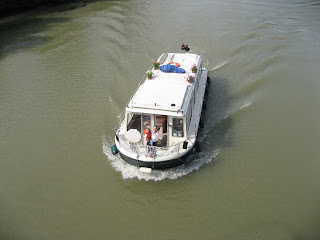 'Cezanne' our floating home in France...
'Cezanne' our floating home in France...
Barry, with a load of supplies on the bike!
Hullo from France.
After arriving in France we hired a rental car & drove to Cambrai, where we spent 2 days doing a boating course to obtain a certificate of competence , which boat owners need to use the waterways. We then called on some friends at Chalon en Champagne, to collect a box of clothing etc, which we left with them last year. Our boat, named Cezanne, was at Lagarde, on the Canal du Marne au Rhin. We spent several days there, recovering from our flight& the busy days & nights at Cambrai. We also spent time shopping & cleaning Cezanne.
It was then time to do a trial run N.E. from Lagarde, for 4 days, traveling as far as Lutzlebourg, which is a pretty town, which also has a crystal making workshop & sales. On this stretch of canal we passed thru’ 2 tunnels, the longest being 2 ½ Kms. Also a transverse incline plane at Saint Louise-Arzviller. It is the only such construction in Europe & allows boats to cross a 45m. change in altitude which would otherwise require 17 locks. Back at Lagarde we did a few more additions & alterations, before setting off on the 4th June to do a round trip.
We continued down the Marne au Rhin canal to Nancy where we stayed 4 nights. Nancy has a big central square called Stansislas Square. The big buildings surrounding it are ornamented with guilt covered statues & in the centre of the square is a big statue of Stansislas, the ex King of Poland, who was gifted the area of Lorraine. On Sat. night we celebrated my birthday by dining out, then sitting in a café in the square, “people watching”. There had been a festival that day with a brass band playing music in the square & entertainment for the children. At 10.45, when it was dark, there was an electric light show against the Marie{town hall).
We then traveled on the Canal des Vosges to Epinal.. During wet & windy weather Barry started making shelving for the kitchen. We spent several days in Epinal . It was also a pleasant change to wander the streets & go to the markets.
From there we went to Corre at the head of the R. Saone. This took 5 days as there were many locks. The 1st day there were uphill locks which were close together, so I walked between the locks to make it easier to put the ropes around the bollards. During these days we traveled through lovely forested country with big trees alongside the canal & birds singing merrily all day long. We then went down the Petite Saone to St. Jean de Losne where we are at present. There is a big marina here which is well equipped for boating people. They also have wifi ,so that is why I am able to use our computer. We have had trouble using it elsewhere . I have written several letters & lost them!!!!!!! We are staying here a few days to do some painting on the boat & give it a bit of TLC. It is also a very social place where some people winter over. There are a few Brits. & NZ’, ders here. From St. Jean de Losne we go up the Canal de Bourgogne via Dijon for 242 kms. To the R. Yonne, then to the R. Seine & Paris. We return to Lagarde via the Marne R. & the Canal Marne au Rhin.----Then it is time to return home!!!!
This morning we went to the market & bought fruit & vegetables. The fruits in season
At present are cherries, strawberries other berries & apricots.
We are both well & enjoying our canal boating challenge.
We hope you are all happy & well. We would love to hear news from you & know if you receive this letter.
Regards,
Margaret & Barry.

 Ella slotted straight into her bed for the holiday with new soft toy friends she was as happy as a bug in a rug...
Ella slotted straight into her bed for the holiday with new soft toy friends she was as happy as a bug in a rug...


























